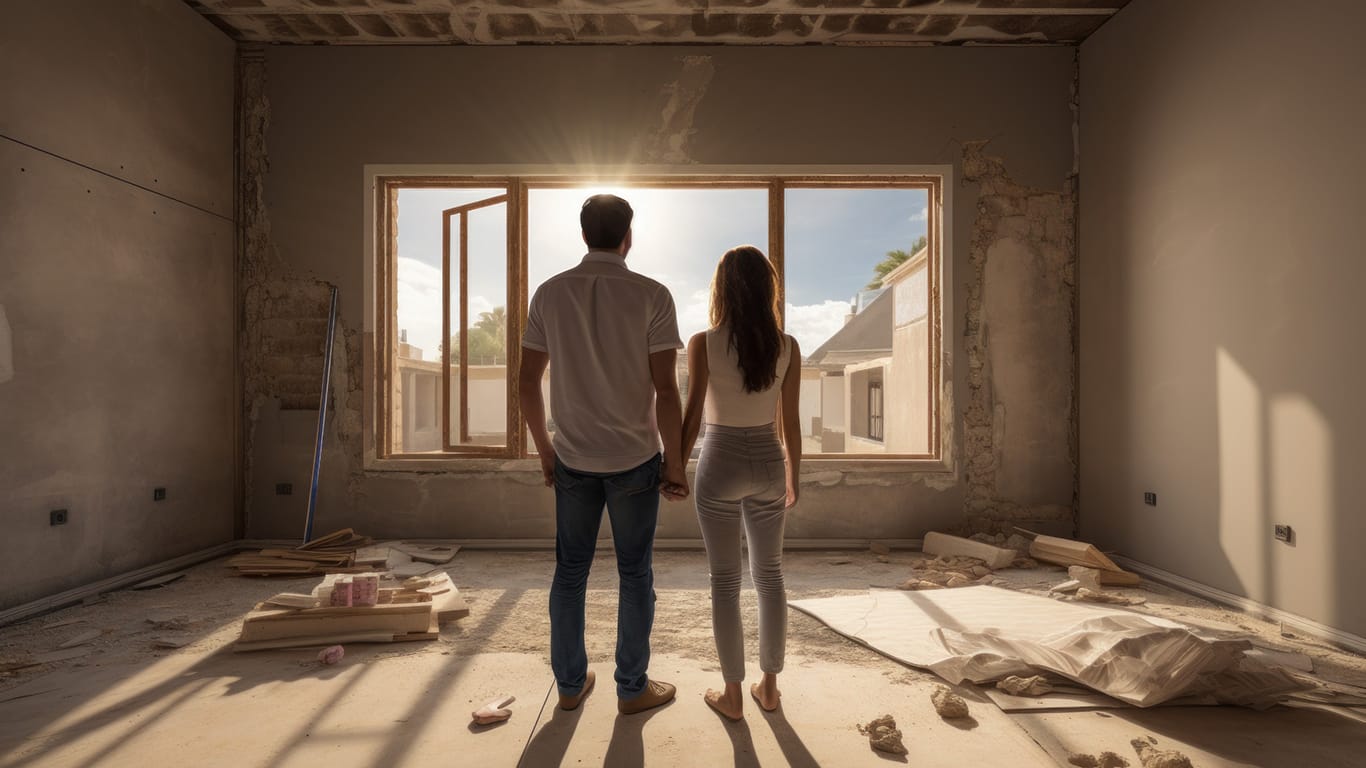Feeling trapped in a home you own? You’re not alone.
High mortgage interest rates are hurting the housing market, and many homeowners cannot now afford to sell.
MORE NEWS: Ranking Arizona: Top 10 home builders for 2024
Our survey of 1,000 U.S. adults who bought homes between 2020 and 2023 shows that 58% of respondents feel “locked in.” That might mean they’re living in a house that’s not big enough for their growing family or accessible enough to age in place.
Challenging market conditions are limiting American homeowners’ ability to upsize, downsize, or relocate. As a result, many say they’re delaying important life decisions like having children or taking a new job. And more than half of our respondents said they’ve changed their long-term living plans (e.g., retirement) to keep affordable loans.
But homeowners are adapting: Our survey data shows that homeowners are leaning into renovations to transform their current house into their dream home.
Keep reading for insights into how fellow homeowners are feeling about and adapting to the current market conditions. We’ll dig into the numbers behind the trends.
KEY TAKEAWAYS
- 52.6% of respondents had mortgage interest rates below 5%. Rising interest rates mean many American homeowners can’t afford to sell their homes.
- 34.4% of homeowners hope to improve the value of their homes and are ready to move when housing interest rates are more favorable.
- Feeling stuck in their rate is forcing some people to delay important life decisions — 36.9% said they’ve turned down jobs because they can’t afford to move, and 29.5% said they’ve put off having children due to space.
- 83.5% said their needs have changed since they moved in, while 59.5% said they have plans to renovate their house.
- 44.19% said kitchen upgrades were their most needed home improvement project. Other top responses included flooring, cosmetic updates, and bathroom remodels.
SHIFTING EXPECTATIONS IN A CHANGING MARKET
Record-low interest rates during the COVID-19 pandemic made it easier than ever for American homeowners to upsize, downsize, or relocate. The average rate for a 30-year, fixed-rate mortgage dipped as low as 2.65% in 2021, fueling a housing boom that helped send housing prices sky-high.
But times have changed. While home prices have remained relatively high, average 30-year rates have soared, reaching a peak of 8.01% in late 2023. By late 2024, that average had dipped below 7%.
While rates now appear headed downward, homeowners locked in at lower rates are reluctant to let go of them. And rightfully so. Purchasing a home at today’s rates would mean adding hundreds of dollars to monthly mortgage payments for those who landed pandemic-era rates.
More than three-quarters of our survey respondents (78%) reported having mortgage rates below 6%, and more than half (52.6%) have rates below 5%.
Just how much would today’s interest rates add to monthly mortgage payments for these homeowners? Let’s say you locked in a 3% interest rate on a 30-year, fixed-rate mortgage in 2021 and your loan balance is $350,000. Not factoring in property tax obligations, home insurance, or other potential costs, your monthly payment would be $1,476. Now say you borrowed the same amount today at an interest rate of 7%. Your monthly payment would shoot all the way up to $2,329.
Our survey found that 41.5% of respondents believe they’ll live in their current home longer than intended. Nearly 70% said they’d originally planned to stay in their house for fewer than 10 years.
And it’s not just interest rates, but also house prices:
- Nearly half (47.2%) admitted they wouldn’t be able to afford their own home if it were on the market today.
- More than one-third (38.6%) said that houses suiting their needs are “way overpriced” in their local markets.
Given the median home sales price in the U.S. was $412,300 in the second quarter of 2024, those claims aren’t surprising. That’s up significantly from a median of $322,600 in the second quarter of 2020 — at the outset of the pandemic.
It’s quite simply financially prohibitive for many homeowners to sell their homes and buy new properties in that sort of economic reality. And that’s why many homeowners say they can’t afford to sell, leaving them “stuck” — locked into houses that may no longer meet their needs.
HOW INTEREST RATES INFLUENCE LIFE DECISIONS

Homeowners are feeling the impact of high mortgage interest rates beyond just their bank accounts. In some cases, it’s causing them to delay major life decisions like having kids. In other cases, it’s changing people’s plans altogether.
It’s all part of the housing market “lock-in effect” — when homeowners are reluctant to sell their homes. This limits the number of houses on the market and makes it more difficult for homebuyers to find a new home.
With housing interest rates at their highest in decades, many homebuyers we surveyed were hesitant to move. Our survey illustrates just how much homeowners feeling locked into their mortgage rates is affecting big life decisions:
- 22.9% of respondents admitted that they would like to move but feel trapped by current rates.
- Nearly 43% have put off moving closer to relatives, and 36.9% have turned down job opportunities because they can’t afford the housing costs in a new location.
- Nearly 30% of survey participants said they have delayed having children (or more children) due to the lack of space in their current homes.
The consequences of higher mortgage rates also affect older homeowners:
- More than half of the respondents (54.3%) said they’ve changed their long-term living plans to maintain their current favorable mortgage rate.
The lock-in effect may be keeping homeowners in their current homes. But many remain optimistic despite current market conditions.
MAKING THE MOST OF THE SITUATION
Despite respondents feeling stuck, our survey revealed a surprisingly positive outlook among many homeowners:
- More than a third (34.4%) of respondents hope to improve the value of their home and are ready to move when interest rates are more favorable.
Our findings show that many homeowners are seeking ways to make the most of their current living situations. This could mean extensive renovations, DIY upgrades, or simply waiting for more favorable market conditions.
The data also shows that many homeowners recognize that, despite their current challenges, they are in a better position than those trying to enter the market now. More than a quarter (26.1%) of respondents expressed relief that they purchased their homes before rates surged. Not all homeowners shared in the optimism. Nearly 15% of respondents expressed frustration at being unable to move without sacrificing their current mortgage rate, and 13.8% felt resigned to being stuck in the same house for the foreseeable future.
85% OF HOMEOWNERS WANT TO REMODEL
Most homeowners expect to make changes when buying a new house. For some, that means taking on a “project” house that needs extensive work. For others, it means buying an “almost perfect” home that needs only minor or stylistic updates like a new kitchen window or French door installations.
According to our survey, 59.5% of respondents have definite plans to renovate their current home. Another 25.1% said they want to renovate, even if they haven’t started planning yet.
For many, renovations are the answer to the lock-in effect.

Rather than taking on a higher mortgage payment to buy a new house or waiting for rates to cool, it seems homeowners are willing to put in the work to make their houses what they want or need them to be. So much so that 62.1% of our survey respondents said they’d rather finance a home improvement project than pay a higher mortgage on a house that meets their needs.
When considering major renovations like full bathroom remodels or complete kitchen overhauls, 59% of homeowners said they’d hire a reliable contractor to save time and effort, even if it costs more than doing it themselves.
RENOVATING YOUR HOME TO MATCH YOUR NEEDS

As you spend more time in your home, your needs and preferences can change. This might lead you to want to renovate, upgrade, or add on to your home.
If this sounds like you, you’re not alone. According to our survey data, only 16% of respondents said their needs “haven’t changed” since moving into their home.
We asked homeowners how their needs have changed since they bought their current house:
- 39.8% said they need more space.
- 30.6% said their design tastes have changed.
- 30.2% said they need more storage.
- 24.1% said they need accessibility features their house doesn’t have.
With the 1-2 punch of high housing costs and mortgage rates, many homeowners simply can’t afford to buy a house with everything they want. That’s why 30.2% said they’d wait it out and move when it makes more financial sense.
But some can’t or don’t want to wait — 33.7% said they’re planning renovations to make their home a better fit.
MOST-NEEDED HOME RENOVATIONS

If you were stuck in your current home longer than planned, which home improvement projects would top your list? Here’s what our survey respondents said their spaces needed the most:
- 44.2% said major kitchen improvements, such as new appliances and countertops.
- 44% said it was updating their flooring.
- 42.5% cited cosmetic updates throughout the home, such as fresh paint, new wallpaper, and updated fixtures.
- Bathroom renovations were also a major priority, with 41.6% of respondents seeking a full bathroom remodel and 38.5% looking to update their showers or baths.
Other home improvement projects homeowners said they wanted were:
- Minor kitchen improvements, such as fresh hardware: 38.5%
- Updated windows: 37.8%
- Outdoor living improvements: 36.4%
- New bathrooms or bedrooms as part of home additions: 35.5%
It’s no surprise that high-traffic areas like the kitchen and bathroom top the list for projects. Improving functionality in the spaces you use every day is part of what makes a house a home. Plus, these types of projects tend to add resale value — even if that resale is happening much further in the future than you thought.
MAKING A “FOREVER” HOME
“Aging in place” describes the ability to live in one’s own home safely, independently, and comfortably as they get older. Today’s high-interest rate environment may be shifting some homeowners’ focus more toward aging in place instead of downsizing.
In fact, more than half of our survey respondents (54.3%) said they’ve changed their long-term living plans, including decisions about retirement, to keep their current mortgage rate.
For many Americans, that means their current home is their “forever home.”
According to our survey, 20% of homeowners consider their house a forever home, while another 26.5% said their home wasn’t intended to be a lifelong residence, but they now consider it to be.
Making your current home your forever home can be labor intensive. It might mean investing in renovations that support aging in place, like improved accessibility or safety features.
Those sorts of renovations can be expensive, especially with higher inflation and higher borrowing costs. Nearly half of the homeowners we surveyed (46.5%) said the cost of accessibility renovations was among their top three concerns about aging in place.
Other major concerns included the ability to keep up with routine chores and maintenance (48.8%) and ensuring home security and safety (45.1%).




